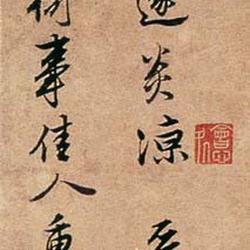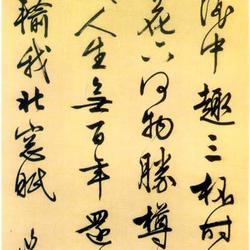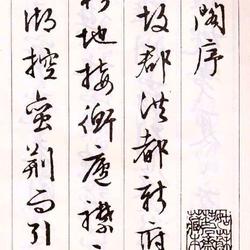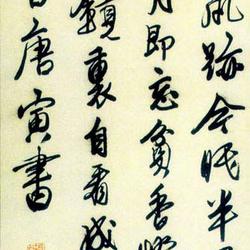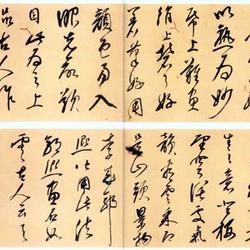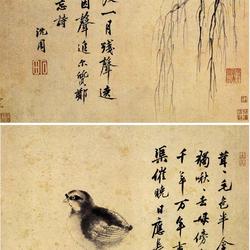
Tang Yin's "Self-written Poems" (detail) in running script, length 23.3 cm, width 551.3 cm. Originally collected by the Palace Museum in Beijing
Tang Yin's "Self-written Poems" has a total of 152 lines, divided into three suites: "Jixian Bin", "Jinyi Gongzi" and "Shanshan Sheep". The three-character name of the brand "Jixianbin" is written in the first line of writing, and the first chapter of "Wu Chi" Zhu Wenying is stamped on the upper right. The last payment is signed "Jinchang Tang Yinlu, like a brother from the Han Dynasty Qing Dynasty", and the seal "Xuepu Hall Seal" is stamped in white. Chapter, "Tang Ziwei Book" Zhu Wenfang Zhang. This painting also bears six imperial seals including "Jiaqing Yulan Zhibao". It is an old collection of the Qing Palace. This work has a careful structure, dynamic brushwork, width and smoothness, adhering to Tang Yin's style.
Wang Shizhen's evaluation of "bad weak ears" has weak writing power and soft strings. Just as Zhao Erxin wrote at the end of the volume, "Mi Lao's brushwork is used everywhere, with a pure and thick flavor, and there is no weak connection." When reading the scroll, the generosity revealed in the poems, the lofty sentiments of drinking wine and singing, are perfectly integrated with the vigorous and free brushwork and flowing strokes of calligraphy, giving people a thrilling, vigorous and stretched feeling. momentum.
It is generally believed that Tang Yin's paintings are better than poems, and poems are better than words, so the title of his book has long been concealed by the name of his painting. "Jingzhiju Poetry Talk" said that Tang Yin "was quite self-respecting and meticulous in painting, while his poems were written quickly and carelessly." Zhu Yunming's "Tang Ziwei Epitaph" said that "in the poetry of the world, he was not very thoughtful. , saying that future generations will know that this is not true." Because of this, Tang Yin's calligraphy works are rarer than those of his friends Wen Zhengming and Zhu Zhishan, and there are only a few poetry volumes except rulers and tablets.
This "Self-written Poetry Scroll" is the representative work of Tang Yin's calligraphy in his later years. This volume was collected by Zhao Erxin, the owner of Aolai Mountain House and a member of the Zhenglan Banner of the Han Army, and was published as a separate volume in his "Five Dynasties Ink Traces" during the Republic of China. During the Cultural Revolution, it was involved in the collection of the Palace Museum. During the national cultural and museum collection tour organized by the State Administration of Cultural Heritage in the 1980s, it was unanimously recognized by five senior experts in the field of calligraphy and painting appraisal, including Qigong, Xie Zhiliu, and Xu Bangda, and was published in the Catalog of Ancient Chinese Paintings and Calligraphy. 》The first episode is about the collection of the Palace Museum. In the late 1980s, this volume was returned to its original owner. In 2000, in order to allow calligraphy enthusiasts to appreciate it, Changhong Publishing House published it in the book "Guanzhi on Chinese Running Script" with Xu Bangda and other experts as consultants.
Tang Yin's works have been cherished by collectors of all generations due to his high reputation and few handed down works. However, a large number of fakes have flooded the market, making people shun them. Works such as "Zi Shu Shi Volume", which are published with detailed descriptions and unanimously recognized by experts, are in the market. This is the first time it has appeared at auction, and it will surely attract the attention of collectors at home and abroad.
Different, their writing styles vary greatly with age. Before the age of thirty, Tang Yin was full of energy and talents, and his unstoppable momentum without setbacks was fully reflected in his poems. The corresponding calligraphy also showed a profound foundation in Tang Kai, with dignified fonts and rigorous rules. Unfortunately, very few calligraphy works from this period have survived, and we can only get a glimpse of it from his early painting inscriptions. From 1499 to 1515, Tang Yin was in his prime, and his physical and mental condition was in the best creative stage. The abolishment of the examination room and the abandonment of his relatives and friends also gave him more free time to create. The calligraphy style at this stage showed two different aspects. Some rulers with formal forms and respectful words were often graceful and graceful. However, when singing among acquaintances and friends, the style is unique, and the pen is strong and free.
After returning to Nanchang in 1515, Tang Yin entered the late period of his calligraphy creation. At this time, Tang Yin lived as a widow in the countryside and occasionally painted to support himself. After experiencing many setbacks, he became tired of the worldly world. While practicing Zen and believing in Buddhism, he became more focused on painting and calligraphy. Unlike other calligraphy masters in his prime, calligraphy at this time has reached a state of perfection, showing its true character of a piece of spiritual power flowing away. This "Self-written Poetry Volume" was created during this period. It has a total of 33 lines and 178 words. It is full of energy, eloquence and one breath. It perfectly integrates the writing styles of Zhao Mengfu, Minangong, Li Beihai and others. . The words "一", "面", etc., were written against the front, and then closed up. The explanations were clear, showing excellent regular script skills, relaxed rhythm, and extremely natural combination of thickness, length, and length, without any trace of artificiality. The words "kan" and "zhuang" are written boldly and quickly, with clear bones and strong strokes, and have Li Beihai's style of writing. The calligraphy in this volume is as easy as the poetry, and the writing is full of enthusiasm and continuous writing style. Tang Yin's calligraphy in his later years often had typos and omissions due to his fast writing. In this volume, the word "人" in the sentence "But hate the human heart is not as good as in ancient times" is omitted, that is, it is randomly added to the side of the line. In the writing process, it is emotion that drives the pen and it is truly spontaneous. Nothing is seen in this volume
Speaking of Tang Yin, people always think of the image of the "Three Smiles" story as a suave and versatile character. But the real Tang Yin in history was in a state of decline and abject failure. Tang Yin (1470-1523), also known as Bohu and the master of Taohua Temple, became a Buddhist in his later years and had other nicknames such as Liuru Jushi. He was a native of Suzhou, Jiangsu Province. Born into a merchant. He was famous for his talent when he was young and ranked first in the provincial examination (Jie Yuan). During the examination in Beijing, he was imprisoned for being innocently implicated in a fraud case in the examination room. His career was thwarted, and he suffered from family difficulties and experienced ups and downs. After being released from prison, he was determined to make progress and made a living by poetry, calligraphy and painting, and was a bohemian man. In the second half of his life, he built a "Peach Blossom Temple" in Taohuawu, northwest of Suzhou City, and became famous all over the world for selling literary works and paintings. At that time, he studied literature and art with Xu Zhenqing, Zhu Yunming and Wen Zhengming, and they were called "the four talented scholars in Wuzhong". In addition to being good at painting landscapes, figures, ladies, flowers and birds, he is also good at calligraphy and poetry. His poems and essays are included in "The Complete Works of Liu Ru Jushi", and he also has profound calligraphy attainments.
A piece of Tang Yin's "Self-written Poetry Scroll" will be exhibited in Kuang Shichun Auction's "Dharma Calligraphy Sale of the Past Dynasties" in May. This volume was written by Tang Yin for his friend Mr. Yunzhuang. The first paragraph excerpts the contents of two poems he wrote in his later years: "Song of Drinking Wine Under the Flowers" and "Answer to the King at the Banquet". The second paragraph is about the wine rules agreed with his friend Yunzhuang. words. In his later years, Tang Yin escaped from Prince Ning of Nanchang, who later rebelled, and returned home, and lived a life of a hermit in Taohuawu. The seal "Fleeing Zen Immortal Official" in the volume was engraved during this period. At this time, Tang Yin had seen through the world and had no intention of pursuing an official career. His poems were indifferent and not very meaningful. These two poems are included in "The Complete Works of Tang Bohu" and are representative works of his late poetry. It can be seen in the poem that Tang Yin is still unable to heal the trauma left by the examination case, and he has long been discouraged about fame and fortune, so he resorts to drinking to drown his sorrows. While drinking and singing with friends, I feel that life is like a dream and find spiritual sustenance.
Since Wang Shizhen commented in the "Dangzhou Mountain Manuscript" that "Bohu's calligraphy was written in Wuxing Hall, it is worse than weak ears", it is often mistakenly believed that Tang Yin's calligraphy was deeply influenced by Zhao Mengfu, but his writing power was slightly weaker. In fact, Tang Yin studied many subjects, and he focused on it at different times.

